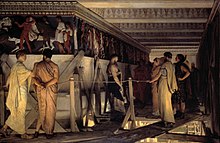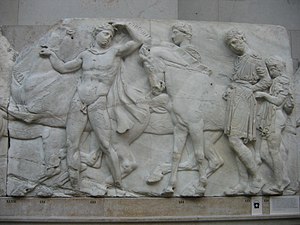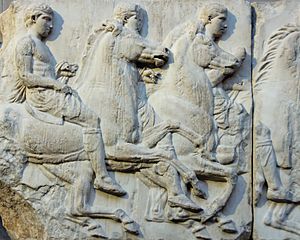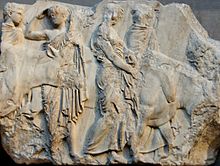http://www.parthenonfrieze.gr/#/home The
Parthenon frieze is the low relief,
pentelic marble sculpture created to adorn the upper part of the
Parthenon’s
naos. It was sculpted between ca. 443 and 438 BC,
[1] most likely under the direction of
Pheidias. Of the 524 feet (160 m) of the original frieze, 420 feet (130 m) survives—some 80 percent.
[2] The rest is known only from the drawings made by Flemish artist
Jacques Carrey in 1674, thirteen years before the
Venetian bombardment that ruined the temple.
At present, the majority of the frieze is at the
British Museum in
London (forming the major part of the
Elgin Marbles); the largest proportion of the rest is in
Athens, and the remainder of fragments shared between six other institutions.
Casts of the frieze may be found in the Beazley archive at the
Ashmolean Museum at Oxford, in the
Skulpturhalle at
Basel and elsewhere.
Construction
Plutarch’s
Life of Pericles, 13.4–9, informs us “the man who directed all the projects and was overseer [episkopos] for him [Pericles] was Phidias... Almost everything was under his supervision, and, as we have said, he was in charge, owing to his friendship with Perikles, of all the other artists”.
[5] The description was not
architekton,
[6] the term usually given to the creative influence behind a building project, rather
episkopos.
[7] But it is from this claim, the
circumstantial evidence of Phidias’s known work on the
Athena Parthenos and his central role in the Periclean building programme that he is attributed authorship of the frieze.
[8] The frieze consists of 378 figures and 245 animals. It was 160 meters in length (524 ft) when complete, as well as 1 meter in height, and it projects 5.6 cm forward at its maximum depth. It is composed of 114 blocks of an average 1.22 meters in length, depicting two parallel files in procession. It was a particular novelty of the Parthenon that the
cella carries an
Ionic frieze over the
hexastyle pronaos rather than
Doric metopes as would have been expected of a Doric temple. Judging by the existence of regulae and
guttae below the frieze on the east wall this was an innovation introduced late in the building process and replaced the ten metopes and
triglyphs that might otherwise have been placed there.
Alma-Tadema's 1868 'Phidias Showing the Frieze of the Parthenon to his Friends', reflecting contemporary reconstructions of the frieze's colour.

The marble was quarried from Mt.
Pentelikon and transported 19 km to the
acropolis of Athens. A persistent question has been whether it was carved
in situ. Just below the moulding and above the tenia there is a channel 17 mm high that would have served to give access to the sculptor's chisel when finishing the heads or feet on the relief; this scamillus or guide strip is the best evidence there is that the blocks were carved on the wall. Additionally, on practical grounds it is easier to move a sculptor than a sculpture, and to
crowbar them into place could have potentially chipped the edges
. No information is recoverable on the workshop, but estimates range from three to 80 sculptors on the basis of style, however Jenifer Neils suggests nine on the grounds that this would be the least number necessary to produce the work in the time given.
It was finished with metal detailing and painted. No colour, however, survives, but the background was perhaps blue judging by comparison with grave stelae and the paint remnants on the frieze of the
Hephaisteion.
Possibly figures held objects that were also rendered in paint such as
Poseidon’s trident and the laurel in
Apollo’s hand.
The many drill holes found in Apollo’s and
Hera’s heads indicate that a gilded bronze wreath would probably have crowned the gods.
The system of numbering the frieze blocks dates back to
Adolf Michaelis's 1871 work
Der Parthenon, and since then
Ian Jenkins has revised this scheme in the light of recent discoveries.
The convention, here preserved, is that blocks are numbered in
Roman and figures in
Arabic numerals, the figures are numbered left to right against the direction of the procession on the north and west and with it on the south.
Description
West frieze, XLVII, 132–136, British Museum
The narrative of the frieze begins at the southwest corner where the procession appears to divide into two separate files. The first third of the west frieze is not part of the procession but instead seems to be the preparatory stages for the participants. The first figure here is a
marshal dressing, W30, followed by several men preparing the horses W28–23 until figure W22 who, it has been suggested,
[18] may be engaged in the
dokimasia, the tryout or enrollment of the
knights.
[19] W24 is an ambiguous figure who might be either the protesting owner of a rejected horse or a
keryx (herald) whose hand held part of an otherwise lost
salpinx (trumpet), but either way this point marks the beginning of the procession proper.
[20]
The following ranks W21–1 along with N75–136 and S1–61 are all of horsemen and constitute 46% of the whole frieze.
[20] They are divided into two lines of ten ranks – the same number of the Attic tribes.
[21] All are beardless youths with the exception of two, W8 and W15, who along with S2–7 wear
Thracian dress of fur cap, a patterned cloak and high boots; these have been identified by
Martin Robertson as
hipparchs.
[22] Next are the four-horse
chariots, each with charioteer and armed passenger, there are ten on the south frieze and eleven on the north. Since these passengers are sometimes depicted as dismounting they may be taken to represent the
apobatai, participants in the ceremonial race found in
Attica and
Boeotia.
[23]
By N42 and S89 the equestrian parade is at an end, and the following 16 figures on the north and 18 on the south are taken to be the elders of Athens judging by their braided hair, an attribute of distinguished age in Classical art. Four of these figures raise their right hand in a clenched fist gesture suggestive of a pose associated with the
thallophoroi (olive branch bearers) who were older men chosen for their good looks in competition. No drill holes, however, exist for any branch to be inserted in their hands. Next in line (S107–114, N20–28) are the musicians: four kithara (a variant of the
lyre) and four aulos (flute) players. N16–19 and S115–118 (conjectured) are the
hydriaphoroi, the water-vessel carriers, here men rather than
metic girls mentioned in the literature on the
Panathenaia. N13–15, S119–121 are the
skaphephoroi, the tray bearers of the honeycombs and cakes used to entice the sacrificial animals to the altar. N1–12, S122–149 are the ten cows on the north and four cows and four sheep on the south meant for sacrifice on the
acropolis, presumably an abbreviated form of the
hecatomb usually offered on this occasion – there is an a-b-a rhythm of placid and restive cows.
Weavers section of the frieze, East VII, 49–56, Louvre, (MR 825).
As the files converge on the east frieze we encounter the first women celebrants E2–27, E50–51, E53–63. They carry the sacrificial instruments and paraphernalia including the
phiale (
phial or jug),
oinochoai (wine jars),
thymiaterion (
incense burner), and in the case of E50–51 they have evidently just handed the marshal E49 a
kanoun, making the girl the
kanephoros.
The next groups E18–23, E43–46, are problematic. Six on the left and four on the right, if one does not count two other figures who may or may not be marshals, then this group might be taken to be the ten
eponymous heroes who gave their names to the ten tribes. Their proximity to the gods indicates their importance, but selecting differently then nine of them may be the
archons of the
polis or
athlothetai officials who managed the procession; there is insufficient iconographic evidence to determine which interpretation is correct. The twelve seated gods are taken to be the Olympians, they are one third taller than any other figure on the frieze and are arranged in two groups of six on
diphroi (backless) stools with the exception of
Zeus who is enthroned. Their backs are turned to what must be the culminating event of the procession E31–35; five figures (three children and two adults, and though badly corroded the two children on the left are probably girls) the girls bear objects on their heads,
[26] while a third, probably a boy,
[27] assists an adult who may be the
archon basileus, in folding a piece of cloth. This is usually understood to be the presentation of
Athena’s
peplos, perhaps by the
arrhephoroi.
[28]
Style
Cavalcade south frieze, X XI, 26–28, British Museum.
The Parthenon frieze is the defining monument of the
High Classical style of Attic sculpture.
[29] It stands between the gradual eclipse of the
Severe style as witnessed on the Parthenon metopes
[30] and the evolution of the Late Classical
Rich style exemplified by the
Nike balustrade. What sources the designer of the frieze drew upon is hard to gauge, certainly large scale narrative art was familiar to 5th century Athenians as in the
Stoa poikile painting by
Polygnotos of Thasos. While there is an overall coherence to the work there are design differences on opposing sides of the frieze which has suggested to some scholars the possibility of more than one designer and a pattern of influence amongst them.
[31] There is greater nudity and frontally on the north than the south, the massing and distribution of figures is greatly different on the east than the more widely spaced west, and the east and north generally exhibit greater innovation. This evidence, along with the frequency with Greek artists were seen to collaborate, has led Jennifer Neils to hypothesize the existence of two designers working on the sculpture.
[32] This would admit the possibility of a later designer comparing and competing with the earlier and so explain the observable changes in composition.
This period is one of discovery of the expressive possibilities of the human body; there is a greater freedom in the poses and gestures, and an increased attention to anatomical verisimilitude as may be observed in the ponderated stances of the figures W9 and W4 who partially anticipate the
Doryphoros of
Polykleitos. There is a noticeable ease to the physiques of the frieze compared with the stiffness of the metopes along with an eye for such subtleties as knuckle joints, veins and the careful articulation of musculature. One important innovation of the style is the use of drapery as an expression of motion or to suggest the body beneath; in archaic and early classical sculpture clothing fell over the body as if it were a curtain obscuring the form below, now there is the billowing chlamydes of the horsemen or the multi-pleated peploi of the women which lends a surface movement and tension to their otherwise static poses. The variation in the manes of the horses has been of particular interest to scholars attempting to discern the artistic personalities of the sculptors who laboured on the frieze,
[33] so far this
Morellian analysis has been without conclusion.
Interpretation
Cattle led to sacrifice, South XLV, 137–140, British Museum.
As no description of the frieze survives from antiquity, the question of the meaning of the sculpture has been a persistent and unresolved one. The first published attempt at interpretation belongs to
Cyriac of Ancona in the 15th century AD who referred to it as the “victories of Athens in the time of
Pericles”.
[34] What is now the orthodox view of the piece, however, namely that it depicts the Greater
Panathenaic procession from
Eleusis to Athens, was mooted by
Stuart and
Revett in the second volume of their
Antiquities of Athens, 1787.
[35] Subsequent interpretations have largely built on this theory even if they disallow that a temple sculpture could represent a contemporary event rather than a mythological or historical one. It has only been in recent years that an alternative thesis in which the frieze depicts the
founding myth of the city of Athens instead of the festival
pompe has emerged.
Procession of guards from the Apadana, Persepolis, 1st half 5th C., inspiration for the Parthenon Frieze?
The contention that the scene is a document of Athena’s festival is fraught with problems. Later sources indicate that a number of classes of individual who performed a role in the procession are not present in the frieze, these include: the
hoplites, the allies in the
Delian league, the
skiaphoroi or umbrella bearers, the female
hydraiphoroi (only male hydrai bearers are portrayed)
thetes, slaves, metics, the panathenaic ship and some would suggest the kanephoros, though there is evidence that she is accounted for.
That what we now see was meant to be a generic image of the religious festival is problematic since no other temple sculpture depicts a contemporary event involving mortals. Locating the scene in mythical or historical time has been the principal difficulty of the line of inquiry.
John Boardman has suggested that the cavalry portray the heroization of the
marathonomachoi, the hoplites who fell at
Marathon in 490, and that therefore these riders were the Athenians who took part in the last pre-war Greater Panathenaia.
In support, he points out, the number of horsemen, chariot passengers (but not charioteers), grooms and marshals comes to the same as the number Herodotos gives for the Athenian dead: 192. Equally suggestive of a reference to the Persian War is the similarity several scholars have noted of the frieze to the
Apadana sculpture in
Persepolis. This has variously been posited to be democratic Athens counter posing itself to oriental tyranny
or aristocratic Athens emulating the Imperial East.
Further to this zeitgeist argument there is J.J. Politt’s contention that the frieze embodies a Periclean manifesto, which favours the cultural institutions of
agones (or contests, as witnessed by the
apobatai), sacrifices and military training as well as a number of other democratic virtues.
More recent scholarship pursuing this vein has made the frieze a site of ideological tension between the elite and the
demos with perhaps only the aristocracy present and merely veiled reference to the ten tribes.
The so-called peplos scene, East V, 31–35, London.
The pediments, metopes and shield of the
Parthenos all illustrate the mythological past and as the gods are observing on the east frieze it is natural to reach for a mythological explanation. Chrysoula Kardara,
[42] has ventured that the relief shows us the first Panathenaic procession instituted under the mythical King
Kekrops. This explanation would account for the absence of the allies and the ship as these post-date the original practice of the sacrificial rite. In evidence she offers E35 as the future
King Erichthonios presenting the first peplos to his predecessor Kekrops, iconographically similar to the boy’s depiction on a fragmentary kylix of the 450s.
[43] A recent interpretation by
Joan Breton Connelly identifies the central scene on the east frieze (hence above the door to the cella and focal point of the procession) not as the handing over of Athena’s peplos by the arrhephoroi but the donning of sacrificial garb by the daughter of King
Erechtheus in preparation for the sacrifice of her life.
[44] An interpretation suggested by the text of the fragmentary papyrus remains of
Euripides’s Erichtheus
[45] wherein her life is demanded in order to save the city from
Eumolpos and the
Eleusinians. Thus, the gods turn their backs to her to prevent the pollution from the sight of her death. A contentious subject in the field, Connelly's solution to the problem of meaning poses as many problems as it answers.
[46]
Influence
Gemma Augustea, Kunsthistorisches Museum Vienna.
The earliest surviving works of art that exhibit traces of the influence of the Parthenon frieze belong to the media of
vase painting and
grave stelae where we can find some echo not just of motifs, themes, poses but tenor, as well. Direct imitation, and indeed quotation, of the frieze begins to be pronounced around 430 BC. One example, an explicit copy, is a
pelike attributed to the Wedding Painter of a youth “parking up” a horse exactly in the manner of the figure W25 on the frieze.
[47] While those vase paintings that resemble the frieze cluster around 430, the vases that quote the pediments are datable nearer to the end of the century, giving further evidence of the priority of the sculptural program.
[48] More accomplished painters also found inspiration in the sculpture, namely
Polygnotos I and his group, especially the Peleus Painter, the
Kleophon Painter and the late work of the
Achilles Painter. Later painters of talent also managed to capture the mood of
eusebeia or thoughtful piety of the procession as, for example, on the volute krater of the
Kleophon Painter of a sacrifice to Apollo,
[49] which shares the quiet dignity of the best of High Classical sculpture.
[50]
The impact of the frieze can be sought in the Attic relief sculpture of the late 5th century; this resonance may be discovered to some degree in the public works of the Hephaisteion frieze and the Nike Athena balustrade, where the imagery of the seated gods and the sandal-binder respectively likely owes a debt to the Parthenon. There are also traces found on the private commissions of grave stelae from the period, for example the “cat stele” from Aegina bears a distinct similarity to the figures N135–6.
[51] As does the Hermes of the four-figure relief known from a Roman copy.
[52] Later classicizing art of the Hellenistic and Roman eras also looked to the frieze for inspiration as attested by the Lycian Sarcophagus of Sidon, Phoenicia, the
Ara Pacis Augustae, the
Gemma Augustea, and many pieces of the
Hadrianic generation.
[53]
 The marble was quarried from Mt. Pentelikon and transported 19 km to the acropolis of Athens. A persistent question has been whether it was carved in situ. Just below the moulding and above the tenia there is a channel 17 mm high that would have served to give access to the sculptor's chisel when finishing the heads or feet on the relief; this scamillus or guide strip is the best evidence there is that the blocks were carved on the wall. Additionally, on practical grounds it is easier to move a sculptor than a sculpture, and to crowbar them into place could have potentially chipped the edges. No information is recoverable on the workshop, but estimates range from three to 80 sculptors on the basis of style, however Jenifer Neils suggests nine on the grounds that this would be the least number necessary to produce the work in the time given.It was finished with metal detailing and painted. No colour, however, survives, but the background was perhaps blue judging by comparison with grave stelae and the paint remnants on the frieze of the Hephaisteion. Possibly figures held objects that were also rendered in paint such as Poseidon’s trident and the laurel in Apollo’s hand.The many drill holes found in Apollo’s and Hera’s heads indicate that a gilded bronze wreath would probably have crowned the gods.
The marble was quarried from Mt. Pentelikon and transported 19 km to the acropolis of Athens. A persistent question has been whether it was carved in situ. Just below the moulding and above the tenia there is a channel 17 mm high that would have served to give access to the sculptor's chisel when finishing the heads or feet on the relief; this scamillus or guide strip is the best evidence there is that the blocks were carved on the wall. Additionally, on practical grounds it is easier to move a sculptor than a sculpture, and to crowbar them into place could have potentially chipped the edges. No information is recoverable on the workshop, but estimates range from three to 80 sculptors on the basis of style, however Jenifer Neils suggests nine on the grounds that this would be the least number necessary to produce the work in the time given.It was finished with metal detailing and painted. No colour, however, survives, but the background was perhaps blue judging by comparison with grave stelae and the paint remnants on the frieze of the Hephaisteion. Possibly figures held objects that were also rendered in paint such as Poseidon’s trident and the laurel in Apollo’s hand.The many drill holes found in Apollo’s and Hera’s heads indicate that a gilded bronze wreath would probably have crowned the gods.






